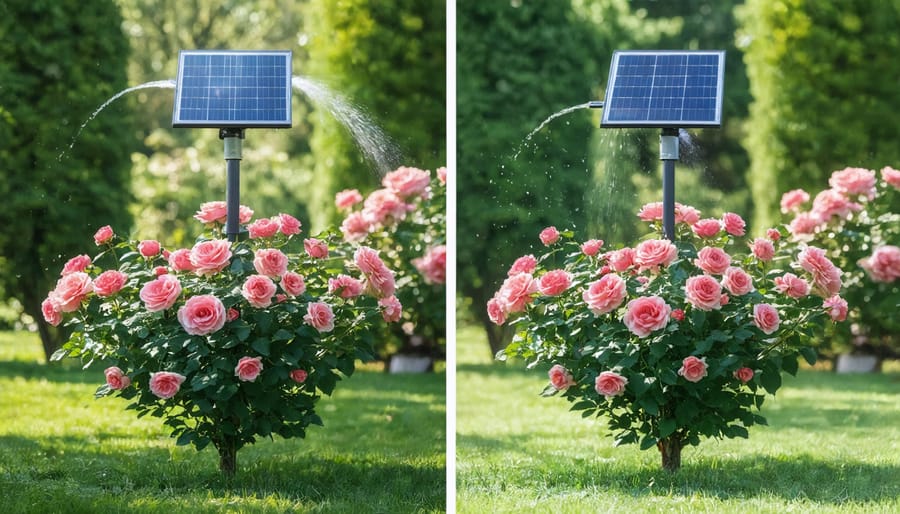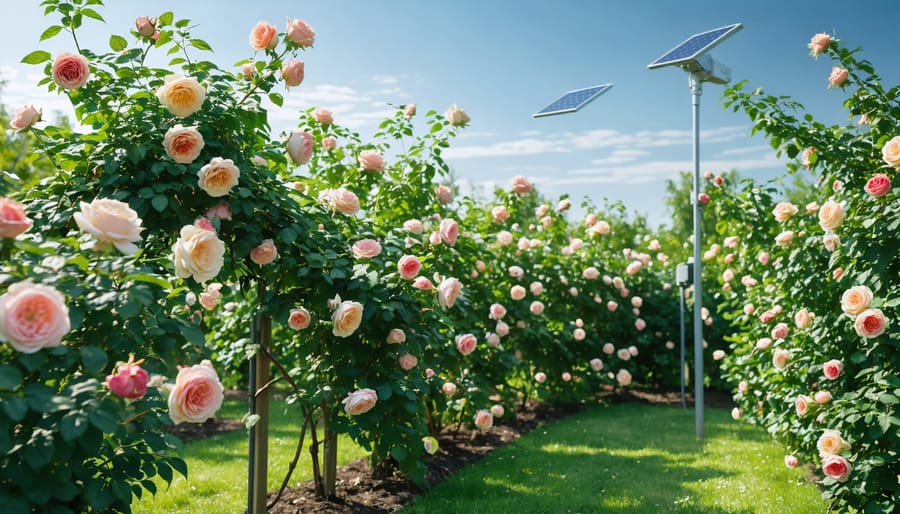Transform your rose garden into a solar-powered oasis by positioning climbing varieties along south-facing trellises, maximizing exposure for optimal solar in the garden performance. Install solar-powered drip irrigation systems precisely between rose beds, delivering consistent moisture while conserving water and reducing utility costs. Integrate solar garden lights strategically around pathways to extend viewing hours and highlight specimen roses, particularly beneficial for garden care for miniature roses that benefit from controlled lighting conditions. Place solar-powered ventilation fans near dense rose clusters to improve air circulation and prevent fungal diseases, especially crucial in Newburyport’s humid coastal climate. Consider solar-powered pH monitors to maintain optimal soil conditions, ensuring your roses thrive while embracing sustainable gardening practices. These energy-efficient solutions not only enhance rose growth but also create an environmentally conscious showcase garden that blooms magnificently throughout the season.
Smart Solar Positioning for Your Rose Garden
Mapping Your Garden’s Sun Patterns
Understanding your garden’s sun patterns is crucial for growing healthy, vibrant roses. Start by creating a simple sun map of your garden using a notebook and compass. Over one day, observe and record sunlight patterns at three key times: morning (8 AM), midday (noon), and afternoon (4 PM). Mark areas that receive full sun (6+ hours), partial sun (4-6 hours), and shade (less than 4 hours).
For more accurate tracking, place small stakes or markers in your garden and note how shadows move throughout the day. Remember that sun patterns shift seasonally – what’s sunny in summer might be shaded in winter. Here in Newburyport, our coastal location means we often deal with maritime influences on sunlight, so it’s worth tracking patterns across different seasons.
Consider using a sun calculator app on your smartphone, or simply take photos at regular intervals to create a visual record. Pay special attention to structures like fences, trees, or buildings that might cast shadows on your rose beds. This mapping exercise will help you determine the ideal spots for different rose varieties and ensure your garden thrives with proper sun exposure.

Strategic Rose Placement
Proper placement of roses in your garden is crucial for maximizing natural sunlight exposure and ensuring healthy blooms. Most roses require 6-8 hours of direct sunlight daily, so start by mapping your garden’s sun patterns throughout the day. Position your most sun-loving varieties, like hybrid teas and floribundas, in areas that receive full morning sun, which is gentler than harsh afternoon rays.
In Newburyport’s coastal climate, consider creating graduated levels in your garden, with taller roses positioned on the north side and shorter varieties toward the south. This prevents larger plants from casting shadows on smaller ones. For areas that receive partial shade, plant more tolerant varieties like David Austin roses or climbing roses that can be trained toward the sun.
Use light-colored fencing or walls to reflect additional sunlight onto your roses, particularly in areas that might receive slightly less direct sun. Remember to space your roses appropriately – typically 24-36 inches apart – to prevent them from shading each other as they mature. For container gardens, opt for mobile planters that can be repositioned throughout the season to follow the sun’s path.
Solar-Smart Watering Solutions
Natural Heat Management
Managing heat and moisture in your rose garden naturally is essential to grow healthy roses. Here in Newburyport, where summer temperatures can fluctuate significantly, implementing smart water management techniques can make all the difference in your garden’s success.
Start by adding a 2-3 inch layer of organic mulch around your roses, keeping it slightly away from the stems. This natural barrier helps maintain consistent soil moisture and reduces water evaporation, especially during hot summer days. Straw, wood chips, or dried leaves work wonderfully, and they gradually break down to enrich your soil.
Consider companion planting with low-growing, spreading plants like creeping thyme or portulaca around your roses. These living mulches shade the soil while adding visual interest to your garden. They also help prevent water from evaporating too quickly from the soil surface.
Create natural windbreaks using trellises or strategic placement of taller plants to reduce moisture loss through evaporation. In our coastal climate, this can be particularly helpful when those brisk ocean breezes pick up. Installing drip irrigation systems or soaker hoses beneath the mulch layer delivers water directly to the roots, minimizing waste through evaporation and helping your roses thrive even during the warmest months.
Solar-Powered Irrigation Options
Solar-powered irrigation systems can transform your rose garden’s watering routine while being environmentally friendly. The most straightforward option is a solar-powered drip irrigation system, which uses a small solar panel to power a pump that delivers water directly to your roses’ root zones. These systems are particularly effective in Newburyport gardens, where summer sunshine provides ample energy for consistent operation.
For beginners, consider starting with a basic solar-powered timer connected to soaker hoses. This setup requires minimal installation and maintains steady moisture levels that roses love. More advanced gardeners might opt for smart irrigation controllers with moisture sensors, which automatically adjust watering schedules based on soil conditions and weather patterns.
Another practical solution is installing a solar-powered fountain pump in a rain barrel. This combination provides stored rainwater for irrigation while using free solar energy to generate the necessary water pressure. Position the solar panel in a south-facing location, ensuring it receives at least 6 hours of direct sunlight daily for optimal performance.
For smaller gardens, portable solar-powered watering wands offer flexibility and convenience. These handheld devices can be charged during the day and used for precise watering in the evening when roses best absorb moisture. Remember to position irrigation components to avoid interfering with rose growth and maintenance access.

Solar-Enhanced Growth Techniques
Heat-Trapping Materials
Maximizing heat retention in your rose garden can significantly boost growth and extend your blooming season. In Newburyport’s variable climate, incorporating heat-trapping materials is especially beneficial during cooler periods. Dark-colored stones and pavers are excellent choices, as they absorb sunlight during the day and release warmth throughout the night, creating a microclimate that roses love.
Consider laying black landscape fabric around your rose beds, which not only retains heat but also prevents weed growth. Installing brick or stone walls near your rose garden serves a dual purpose – they protect against harsh winds while storing solar heat. For container gardens, terra cotta pots naturally retain warmth and provide excellent insulation for rose roots.
Water-filled containers, painted black or dark blue, can serve as thermal mass elements. Place these strategically around your garden to capture and store heat during sunny days. Raised beds with dark-colored mulch or stone borders will warm up faster in spring and maintain higher soil temperatures.
For added protection and heat retention, consider using clear plastic cloches or row covers during colder months. These create a greenhouse effect that traps warm air around your roses while allowing sunlight to penetrate.

Natural Light Reflection
Maximizing natural light in your rose garden isn’t just about direct sunlight – strategic reflection can significantly boost your roses’ exposure to vital solar energy. Light-colored surfaces and carefully positioned reflective elements can create what gardeners call “borrowed light,” enhancing growth even in partially shaded areas. Consider incorporating creative rose garden ideas like white pebbles or pale gravel around your rose beds, which naturally bounce light upward onto the plants’ lower leaves.
Here in Newburyport, many gardeners use light-colored fencing or trellises to amplify available sunlight. Installing mirrored garden ornaments or metallic wind chimes can create dancing light patterns that reach shadier spots. Paint nearby walls or structures in reflective white or pale colors to create natural light boards. For container gardens, try placing light-colored ceramic pots or metallic planters strategically to redirect sunlight.
Remember to position reflective elements on the north side of your rose beds (in the Northern Hemisphere) to maximize light reflection throughout the day. This technique is particularly effective during morning and evening hours when direct sunlight might be limited but your roses can still benefit from reflected light for photosynthesis.
Solar Solutions for New England Gardens
New England’s unique climate presents both challenges and opportunities for solar-powered rose gardens. In Newburyport and surrounding coastal areas, gardeners can maximize sunlight exposure by positioning roses along south-facing walls or fences, which act as heat sinks during our shorter growing season. These structures not only protect delicate blooms from harsh coastal winds but also reflect additional warmth onto the plants.
For optimal results in our region, consider installing solar-powered drip irrigation systems that can handle our irregular rainfall patterns. These systems work particularly well when combined with moisture-retaining mulch like pine needles or bark, which are readily available throughout New England’s wooded areas.
Take advantage of our region’s natural slope variations by creating terraced gardens that capture maximum sunlight. In Newburyport’s historic districts, many successful rose gardens incorporate granite walls – a traditional New England building material – to create heat-retaining terraces that extend the growing season.
During our cold winters, solar-powered garden lights can help extend viewing hours and protect roses from frost damage by providing gentle warmth. Consider installing these lights at strategic points around more delicate varieties, particularly those planted near the coast where temperature fluctuations can be extreme.
Remember to account for snow reflection when planning your garden layout – this natural phenomenon can actually benefit early spring growth when properly utilized. Position white or light-colored elements in your garden to enhance this effect and give your roses an early start in our shorter growing season.
By implementing these solar-smart gardening techniques, you’ll create a thriving rose garden that harnesses the power of natural sunlight efficiently. Remember to position your roses strategically, utilize solar-powered tools for maintenance, and make the most of sunlight patterns throughout the seasons. Your roses will reward you with vibrant blooms and healthy growth while maintaining eco-friendly practices. Whether you’re growing classic tea roses or hardy climbing varieties, these solar-powered approaches work harmoniously with nature. Start small, observe your garden’s unique solar patterns, and gradually expand your solar-smart methods. With patience and these sustainable practices, you’ll develop a beautiful, energy-efficient rose garden that brings joy throughout the growing season. Happy gardening, and may your roses flourish under the nurturing New England sun!

